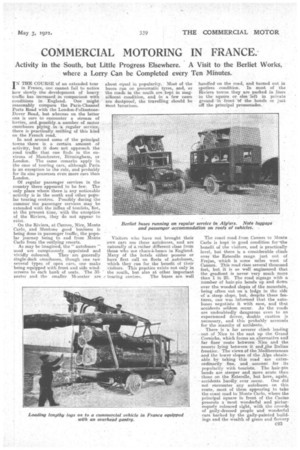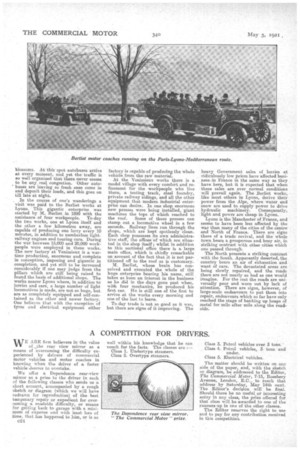COMMERCIAL MOTORING IN FRANCE:
Page 19

Page 20

If you've noticed an error in this article please click here to report it so we can fix it.
Activity in the South, but Little Progress Elsewhere. A Visit to the Berliet Works, where a Lorry Can be Completed every Ten Minutes.
IN THE COURSE of an extended tour in France, one cannot fail to notice how slowly the development of heavy traffic has increased in comparison with conditions in England. One might reasonably compare the Paris-Channel Ports Road with the London-FolkestoneDover Road, but whereas on the latter one is sure to encounter a stream of lorries, and possibly. a number of motor omnibuses plying .in. a regular service, there is practically nothing of this kind on the French road.
In and around some of the principal towns there is a certain amount of activity, but it does not approach the road traffic that one finds in the environs of Manchester, Birmingham, or London. The same remarks apply in. the case of touring cars, although Paris is an exception to the rule, and probably for its size possesses even more cars than London;
Of regular passenger services in the country there appeared to be few. The only place where there is any noticeable activity is in the south and other poPular touring centres. Possibly during the summer the passenger services may be extended with the influx of tourists, but, at, the present time,. with the exception of the Riviera, they do not appear to exist.
, On the Riviera, at Cannes, Nice, Monte Carlo, and Mentone good business is being done in passenger traffic, the popular journey being to and from Monte Carlo from the outlying resorts.
As may be imagined. the " autobuses " used are sumptuously appointed and vividly coloured. They are generally single-deck omnibuses, though one saw several types of open cars, one -make • being equipped with front and side windscreens to each batik of seats. The 30seater and the smaller 16-seater are about equal in popularity. Mostof the buses run on pneumatic tyres, and, as the reads in the south are kept in magnificent condition, and in a few cases are dustproof, the travelling should be most luxurious.
Visitors who have not brought their own cars use these autobuses, and are naturally of a rather different class froin those who use chars-a-bancs in England. Many of the hotels either possess or have first call on fleets of autobuses, which they run for the benefit of their visitors. This practice exists not only in the south, but also at other important touring centres. The buses are well handled on the road, and turned out in spotless condition. In most of the Riviera towns they are parked in lines in the square or else left in private ground in front `tif the hotels or just off the principal promenades.
The coast road from Cannes to Monte Carlo is kept. in good condition for the benefit of the visitors, and is practically level, but there is a considerable climb over the Esterelle range just out of Fiejuts, which is some miles west of Cannes. This road rises several thousand feet, but it is so well engineered that the gradient is never very much more than 1 in 20. The road zigzags with 3 number of hair-pin bends up and iloWn over the wooded slopes of the mountain, • being often cut on a ledge in the side of a steep slope, but, despite these features, one was informed that the autobuses negotiate it with ease, and that accidents seldom occur. As the roads are undoubtedly dangerous even to an experienced driver, double caution is necessary, and this probably accounts for the scarcity of accidents.
There is -a far severer climb leading out. of Nice to the east up the Grand Corniche, which forms an alternative and far finer route between Nice and the resorts lying between it and Jbe Italian frontier. The views of the Mediterranean and the lower slopes of the Alps obtainable by taking this road are extraordinarily fine, and acconnt for its popularity with tourists. The hair-pin bends are steeper and more acute than those on the Esterelle, but here, again, accidents hardly over occur. One did not encounter any autobuses on this route, most of them appearing to take the coast read to Monte Carlo, where .the principal square in front of the Casino presents a most wonderful and .picturesquely coloured sight, with the crowds of gaily-dressed people and wonderful cars backed by the gaily-painted buildings and the wealth of green and flowery
blossoms. At this spot autobuses arrive at every moment, and yet the traffic is so well organized that there never seems to be any real, congestion. Other autobuses are leaving as fresh ones come in and deposit their loads, and this goes on till late at night.
In the course of one's wanderings a visit was paid to the Berliet works at Lyons. This gigantic enterprise was started by M. Berliet in 1899 with the assistance of four workpeople. To-day the two works, one at Lyons itself and the other a few kilometres away, are capable of producing one lorry every 10 minutes, in addition to numberless lightrailway engines and touring cars. During the war between 15,000 and 20,000 workpeople were employed in these works. The new factory at Venissienx is a wartime production, enormous and complete in conception, imposing and gigantic in completion, and yet still to be increased considerably if one may judge from the pillars which are still being raised to found the basis of additional shops. The works nearer Lyons where, in addition to lorries and cars, a large number of light locomotives is made, are not so huge, but are as completely equipped and self-contained as the other and newer factory. One believes that with the exception of tyres and electrical equipment either
factory is capable of producing the whole vehicle from the raw material.
At the Venissieux works there is a model village with every comfort and refinement for the workpeople who live there, a testing track, steel foundry, private railway sidings, and all the other equipment that modern industrial enterprise can desire. In one shop enormous new presses were being installed, giant machines the tops of which reached to the roof. Some of these presses can stamp out a locomotive wheel in a few seconds. Railway lines run through the shops, which are kept spotlessly clean. Each shop possesses its own administrative staff, the offices'of which are situated in the shop itself; whilst in addition to this sectional office there is a. large main office, which is chiefly remarkable on account of the fact that it is not partitioned off to the roof as is customary. M. Berliet, whose brain has conceived and executed the whole of the huge enterprise bearing his name, still takes a.s keen an interest in the business as he did in the days gone past when, with four mechanics, be produced his first ear. Re is still one of the first to arrive at the works every morning and one of the last to leave.
To-day trade is not so good as it was, but there are signs of it improving. The
heavy Government sales of lorries at ridiculously low prices have affected business,in France in the same way as they have here, but it is expected that when these sales are over normal conditions will prevail again, The ,Berliet works, like most others in Lyons, derive their power from the Alps, where water and snow are used to supply power to drive hydraulic machinery. Consequently, light and power are cheap in Lyons.
Lyons is the Manchester of France, and seems to have been less affected by the war than many of the cities of the centre and North of France. There are signs there of a trade revival, and the whole town bears a prosperous and busy air, in striking contrast with other cities which one passed through.
The North presents a striking contrast with the South. Apparently deserted, the country bears an air of exhaustion and want of care. The devastated areas are being slowly repaired, and the roads there are not nearly as bad as one would imagine. For the rest the roads are universally poor and worn out by lack of attention. There are signs, however, of large-scale endeavours to put them into repair, endeavours which so far have only reached the stage of banking up heaps of metal for mile after mile along the roadside.
































